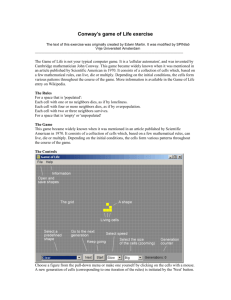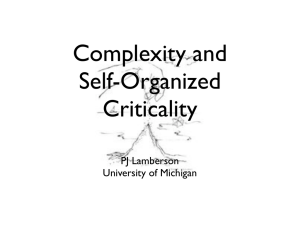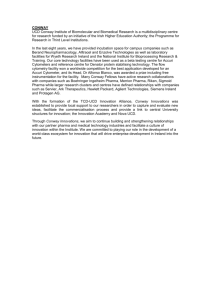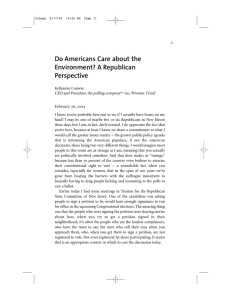Conway's Game of Life
advertisement
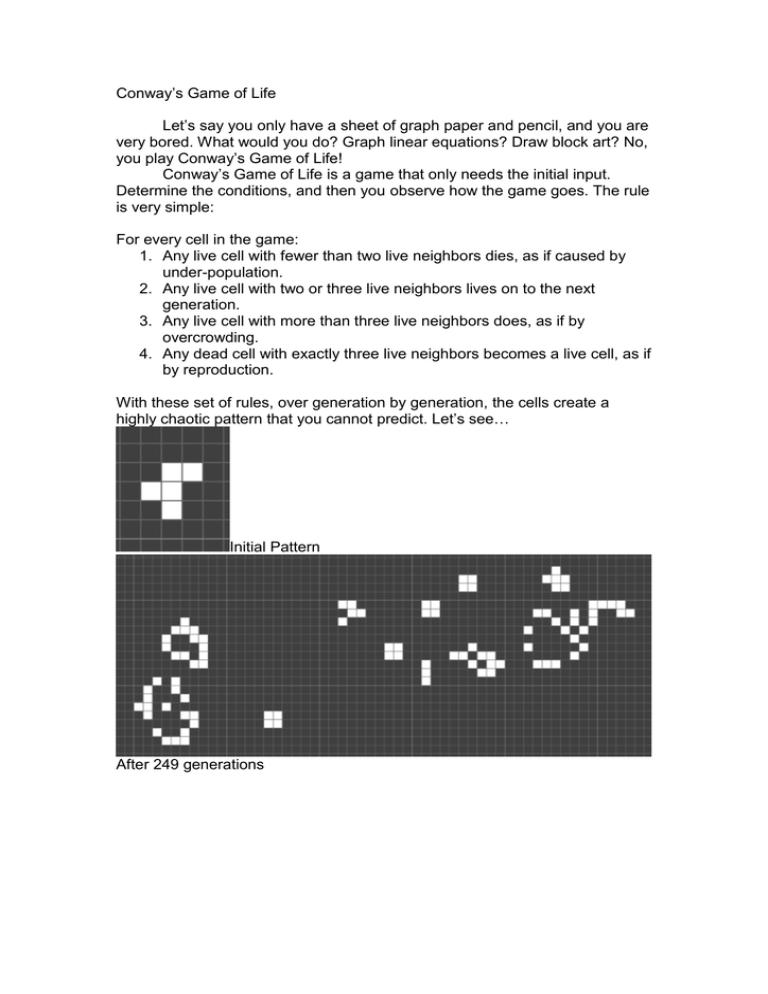
Conway’s Game of Life Let’s say you only have a sheet of graph paper and pencil, and you are very bored. What would you do? Graph linear equations? Draw block art? No, you play Conway’s Game of Life! Conway’s Game of Life is a game that only needs the initial input. Determine the conditions, and then you observe how the game goes. The rule is very simple: For every cell in the game: 1. Any live cell with fewer than two live neighbors dies, as if caused by under-population. 2. Any live cell with two or three live neighbors lives on to the next generation. 3. Any live cell with more than three live neighbors does, as if by overcrowding. 4. Any dead cell with exactly three live neighbors becomes a live cell, as if by reproduction. With these set of rules, over generation by generation, the cells create a highly chaotic pattern that you cannot predict. Let’s see… Initial Pattern After 249 generations Note that this is over 249 generations. Instead of calculating every cell by hand (that would be boring), I used a computer program called Golly, which does the tedious work for you. I recommend playing around with it for a while; there are many example patterns that will blow your mind. However, within those chaotic patterns, orderly patterns do exist. For example, these pattern of cells (called “still lifes”) do not move at all. Note that they are all named by the familiar shapes. There are also patterns that repeat itself over and over (called oscillators): Blinker Toad Beacon Pulsar (I apologize that the animated images do not work. Search on Wikipedia for animated stuff. http://en.wikipedia.org/wiki/Conway's_Game_of_Life) And, there are spaceships, which travel at a constant speed in a certain direction. Block Beehive Glider (moves diagonally at a speed Loaf Boat Lightweight Spaceship (moves of c/4) horizontally at a speed of c/2) Okay, you want to see something more complicated? Let’s do it. Called the Gospel Glider Gun, it spews out gliders continuously over and over again. It is a replicating machine. Simple enough? Let’s see a more complicated pattern. You will probably say, “What the?” What this complicated pattern does is spewing out streams of lightweight spaceships in the interval of prime numbers. Whoah. Or, if you really want something challenging: Tadah! What you now see is a computer. (Again, “What the?”) Yes, a fully operational computer, capable of doing calculations and storing memory. Think about this: if you run this in a computer program, you have a computer in a computer (Awesome!) Note that running this will heat up your computer very quickly. So, this is a pretty fun game after all, but so what? Why is this so important? Well, numerous physicists, biologists, computer programmers, and even philosophers were inspired by this simple game. The fact that chaotic patterns exist from such simple rules, but those chaotic patterns forming a orderly state, is mind-blowing. Now, many scientists are thinking, “If there is a set of rules of our universe, it must by mind-blowingly simple.” Maybe all the atoms and tiny particles that form us are, after all, tiny blocks! In fact, a person found a self-replicating pattern (acting like a living lifeform) in Conway’s Game of Life! Known as the Gemini, it splits into two every 33,699,586 generations. (It is ridiculously big, so only a part of it is shown here) This idea later on inspired me to write my own “theory” (hypothesis to say, because nothing has been proven yet). There are very small particles (I mean very, the Planck length = about 1/100000000000000000000000000000000000 of a meter), in a 3d-grid, moving around by the laws of nature. However, as demonstrated in the quantum physics post before, one cannot predict a quantum particle’s outcome. So, there is a function assigned to every particle, which determines only the probability of a particle moving to that certain position. In easier words, we cannot know the exact movement of a particle, but the likelihood of having one. And those functions may have different types, thus representing different movement patterns (precisely, the likelihood of the patterns), and tendencies of interacting with other particles. Whew, that was a long explanation, and I think it is impossible to put all of my ideas right now. However, I will fully summarize and simplify my ideas in a later post. Anyways, feel free researching more about this game. In fact, there is a dedicated wiki (conwaylife.com), which has over 3,000 kinds of patterns to explore.
